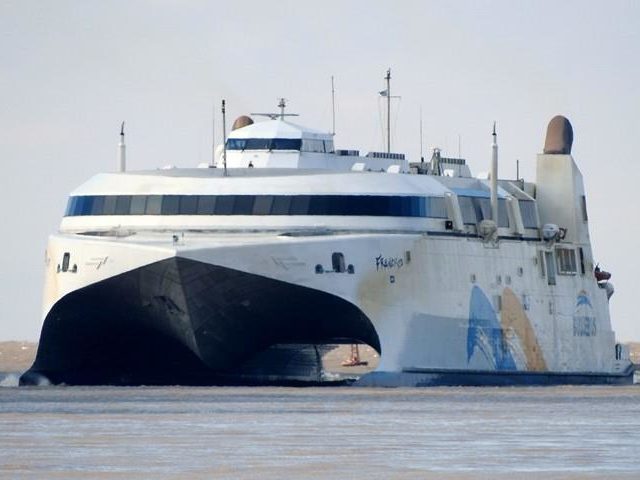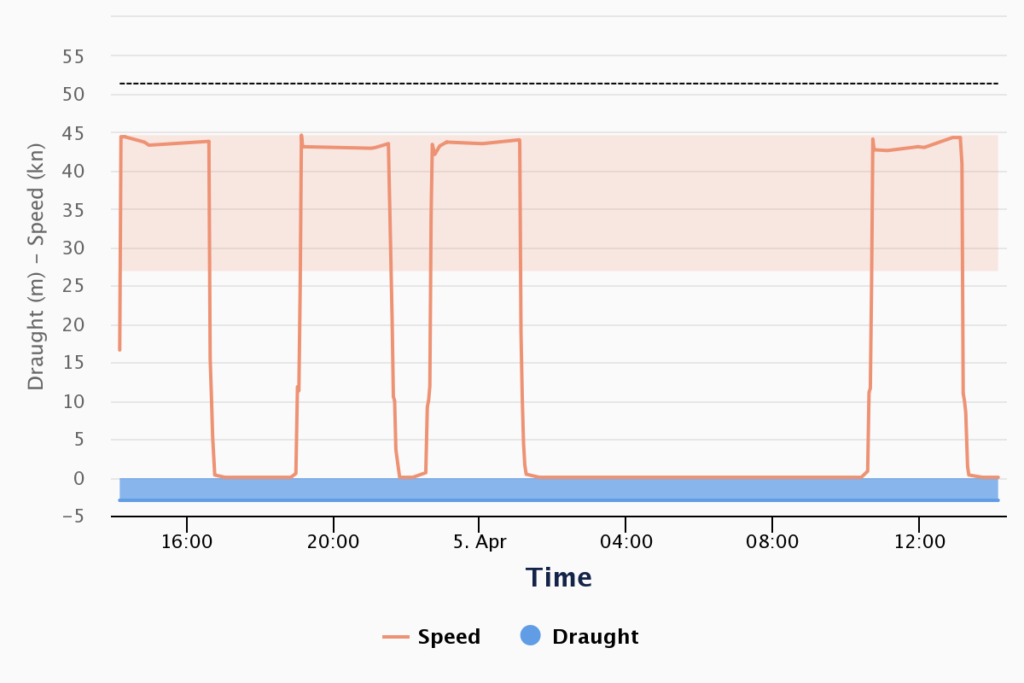Ship transport is a critical mode of global transportation, responsible for moving over 75% of global goods. While historically known for slower speeds, technological advancements have pushed modern ships to new limits, making some faster than many land vehicles.
The Fastest Ship in the World: HSC Francisco
The fastest ship in the world is the HSC Francisco, which achieved its top speed of 58.2 knots (108.1 km/h) when launched in 2013. This high-speed catamaran can carry over 950 passengers and more than 120 cars, setting new standards for speed in maritime transport.
Built by Incat Shipyard in Tasmania, Australia, the ship is named in honor of Pope Francis.

HSC Francisco travels between Buenos Aires and Montevideo. (Photo from MarineTraffic.com).
Key Facts about HSC Francisco:
- Powered by two GE gas turbines that run on marine distillate and liquid natural gas (LNG).
- Fitted with advanced water jets to boost propulsion efficiency.
- Equipped with two LNG storage tanks and four fuel tanks to support long-distance operations.
- Capable of switching between LNG and distillate fuel to optimize efficiency and lower emissions.
How Fast is the Fastest Ship in the World?
The HSC Francisco reaches speeds of 58.2 knots or 108.1 km/h. For comparison, passenger ships typically cruise between 20 to 30 knots. However, during regular service, the HSC Francisco cruises at a more modest 45 knots (83.3 km/h) for fuel efficiency and operational safety.

- Did you know? While the HSC Francisco’s top speed is 58.2 knots, its daily cruising speed is kept lower to ensure optimal safety and fuel economy.
The Zumwalt-class destroyer, an American naval ship, holds the record for the fastest naval vessel. This stealth destroyer travels at speeds exceeding 42 knots thanks to its electric turbines generating over 78 megawatts of power.
While originally designed to reach 80 knots, cost and fuel efficiency concerns led to the reduction in its operational speed. The Zumwalt’s groundbreaking design includes advanced radar-evading features and heavy firepower, making it not only fast but formidable in combat.
What Factors Affect the Speed of a Ship?
Several factors influence a ship’s speed, including:
- Wind Direction & Magnitude: Favorable winds can accelerate ships, while strong headwinds slow them down.
- Ship Structure: Ships with multiple propellers or hydrodynamic hull designs can achieve higher speeds.
- Location: Coastal vessels operate slower due to environmental regulations, while open-water ships cruise faster.
- Weather Conditions: Calm seas allow for higher speeds, while rough seas necessitate slower travel.
- Draft & Cargo: Heavier ships with more cargo move slower; lighter, less-loaded ships can go faster.
Do Different Ships Move at the Same Speed?
Different ship types have varying speeds based on their design and purpose. Passenger ships, for example, are typically faster than cargo ships, which are optimized for capacity over speed.
| Type of Ship | Cargo | Average Speed |
|---|---|---|
| Container Ships | Containers (dry, refrigerated, general) | 25 knots |
| Tanker Ships | Crude oil, chemicals, liquefied gases | 18 knots |
| Bulk Cargo Ships | Grains, ores, coal, heavy goods | 12 knots |
| Ro-Ro Ships | Cars, trucks, tractors | 21 knots |
| Passenger/Cruise Ships | Passengers, cars, pets | 26 knots |
The largest ships in the world, like oil tankers and dry bulk carriers, are among the slowest, averaging around 12 knots. On the other hand, cruise ships prioritize speed to adhere to strict schedules for their passengers.
How Do You Ensure Personal Safety While Cruising on High-Speed Ships?
Safety is a top priority when traveling on high-speed vessels. Here are some practical safety tips for an enjoyable and secure journey:
- Always have access to safety equipment like life jackets, gloves, and headgear.
- Avoid using open flames near flammable cargo.
- Keep a first aid kit handy in case of emergencies.
- Stay clear of heavy cargo to avoid injury, especially on rough seas.
- Ensure ladders and walkways are securely fastened before use.
- Wear appropriate protective gear (e.g., masks, gloves) when handling hazardous materials.
- Follow all crew instructions regarding safety protocols.
By adhering to these guidelines, you ensure a safer experience for both you and the ship’s crew, particularly on high-speed vessels like the HSC Francisco.
Future of High-Speed Ships
The world of shipbuilding continues to evolve, with engineers pushing boundaries in speed, fuel efficiency, and sustainability. With the adoption of alternative fuels like LNG and innovations in hull design, ships like the HSC Francisco showcase the potential for high-speed, environmentally friendly maritime transport.
While current regulations limit the speeds of many cargo vessels to ensure safety and reduce emissions, the future may hold even faster, more efficient ships. Technological advancements will likely focus on balancing speed with sustainability to meet the demands of global trade.
- Types of Gas Carriers as per IGC Code – April 22, 2025
- Wind-Assisted Propulsion Systems (WAPS): A Game Changer for Maritime Decarbonization – February 6, 2025
- 10 Boat Salvage Yards in California – January 25, 2025




Leave a Reply